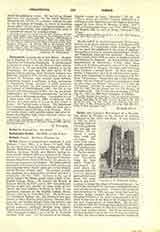

Corbie (also CORBEY), MONASTERY OF, a Benedictine abbey in Picardy, in the Diocese of Amiens, dedicated to Sts. Peter and Paul. It was founded in 657 by Saint Bathilde, widow of Clovis II, and both she and her son Clotaire III endowed it richly with lands and privileges. The latter were subsequently confirmed by Popes Benedict III and Nicholas I. The first monks came from Luxeuil, Theodefrid being the first abbot. Under St. Adelhard, the ninth abbot, the monastic school of Corbie attained great celebrity and about the same time it sent forth a colony to found the abbey of Corvey in Saxony. In 1137 a fire destroyed the monastic buildings but they were rebuilt on a larger scale. Commendatory abbots were introduced in 1550, amongst those that held the benefice being Cardinal Mazarin. The somewhat drooping fortunes of the abbey were revived in 1613, when it was one of the first to be incorporated into the new Congregation of Saint-Maur. At its suppression in 1790 the buildings were partly demolished, but the church remains to this day, with its imposing portal and western towers. One of the most famous scholars produced by Corbie was Pasehaslus Radbert (d. 865), the first to write a comprehensive treatise on the Blessed Sacrament. In the controversy to which this work gave rise, his chief opponent was Ratramnus, one of his own monks, whose views, however, are at variance with Catholic teaching; both treatises are printed in Migne, P.L., CXX—CXXI. The library of Corbie, rich and extensive, was removed to Saint-Germain-des-Pres in 1624.
G. CYPRIAN ALSTON

